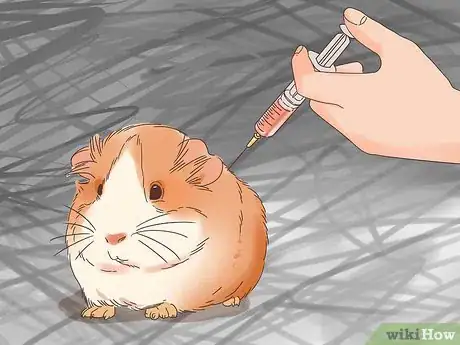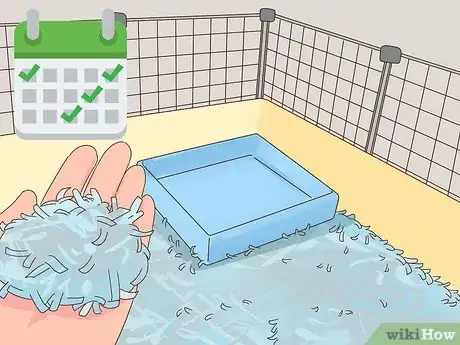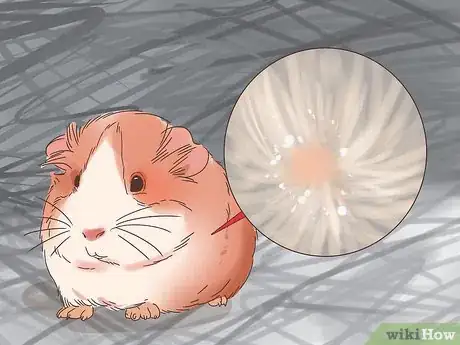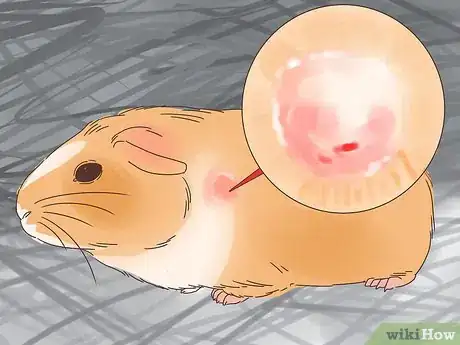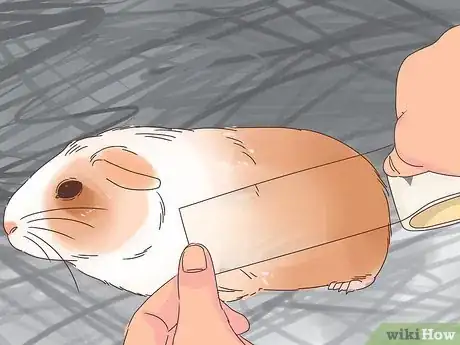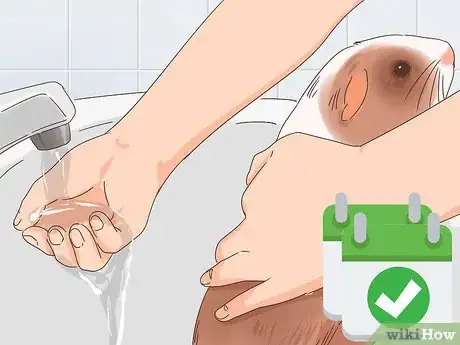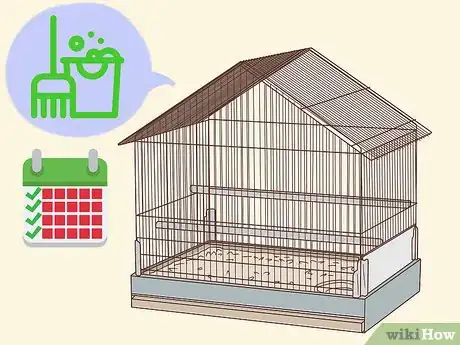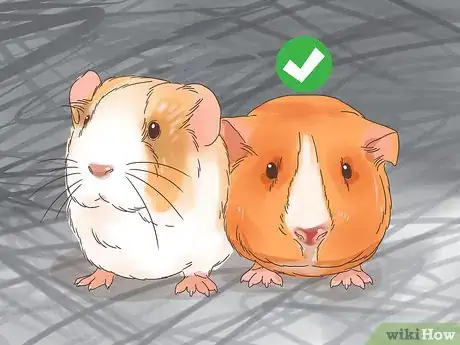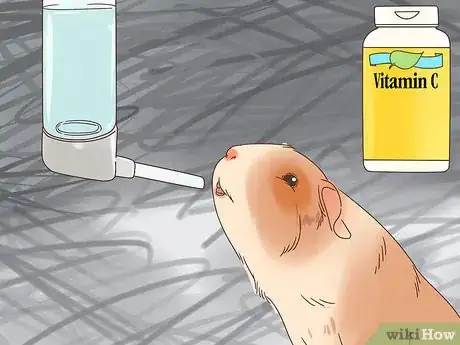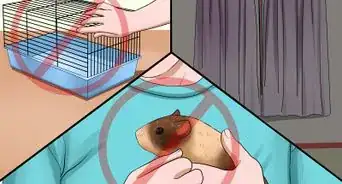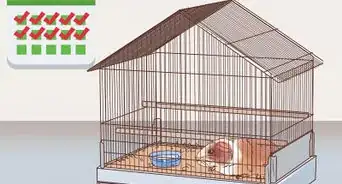This article was co-authored by Pippa Elliott, MRCVS. Dr. Elliott, BVMS, MRCVS is a veterinarian with over 30 years of experience in veterinary surgery and companion animal practice. She graduated from the University of Glasgow in 1987 with a degree in veterinary medicine and surgery. She has worked at the same animal clinic in her hometown for over 20 years.
There are 7 references cited in this article, which can be found at the bottom of the page.
This article has been viewed 97,553 times.
Like most rodents, guinea pigs are at a risk for getting mites and lice, but you can treat your piggy pretty quickly and keep it comfortable. The treatment will depend on what type of mites or lice your piggy has, so you'll need to take it to the vet for a diagnosis. Observing your guinea pig's symptoms will give you crucial information when you see your vet for treatment. You can also do a lot to prevent your piggy from getting mites and lice.
Steps
Using Targeted Treatments
-
1Don't use flea medication. Most flea medications have ingredients that make them poisonous to guinea pigs. If you suspect that your pig has lice or mites, don't just use flea medication on them. Take them to the vet instead.[1]
-
2Get a shampoo or spray for static mites. If your guinea pig has static mites – which makes it look like your pig has dust in their fur – you'll need a special spray or shampoo. You should take your pig to the vet to find out for sure what type of mites it has. If your vet determines that it's static mites, they can give you the shampoo or spray you need.[2]Advertisement
-
3Use a shampoo with ivermectin for sarcoptic mange. Guinea pigs with sarcoptic mange need treatments that get to where the mites are under the pig's skin. Take your guinea pig to the vet to determine if they have sarcoptic mites and get the right type of shampoo.[3]
-
4Administer an oral de-wormer or injection for sarcoptic mites. Because sarcoptic mites live under your guinea pig's skin, you'll also need either an oral de-wormer or an injection to treat this condition. Your vet will be able to prescribe the correct de-wormer. Your vet will give the injection if needed.[4]
-
5Administer oral or injectable meds for lice. Lice are very contagious, so you want to make sure your pig gets treatment right away. Your vet will likely prescribe an oral or injectable medication. It should be administered two to four times total, with two weeks in between treatments.[5]
- If you have more than one guinea pig, you'll need to take them all in to get treated.
-
6Replace your pig's bedding every four days. If your guinea pig has been diagnosed with mites or lice, you should remove all of the bedding in their cage. Spray the cage with whatever spray your vet gives you and then replace the bedding.[6]
Identifying Types of Infestation
-
1Look for “dust” on your guinea pig. If you notice that your guinea pig seems to have dust in its fur, it might have static mites. Try blowing or brushing away the dust – if it doesn't move, your guinea pig likely has static mites.[7]
-
2Check for bald patches. If your guinea pig has bald patches and is biting its skin, it likely has sarcoptic mites. These mites burrow under your guinea pig's skin and cause itching and pain, which your pig will try to get rid of by biting their skin. Take your pig to the vet right away if you notice this behavior.[8]
-
3Use clear tape on your pig. If you notice that your guinea pig is scratching a lot, you can use clear tape to see if there are lice on your pig. Press a strip of tape onto your pig's back and then pull it off and look at it under a magnifying glass. You should be able to see some lice or eggs on the tape.[9]
- Even if you don't see lice under a magnifying glass, take your guinea pig in any way. The vet will have more powerful – and better – ways of diagnosing your guinea pig.
Preventing Mites and Lice
-
1Bathe your guinea pig regularly. You should bath your guinea pigs once every one to two months. Use a guinea pig shampoo, which you can find in most pet stores. If you have multiple pigs, you should bathe them more often.[10]
-
2Use anti-mange shampoo. The anti-mange shampoo will help to prevent your pig from getting sarcoptic mites. The treatment for sarcoptic mange, caused by sarcoptic mites, is pretty intense, with multiple treatments and lots of potential pain for your pig, so prevention is a really good idea.[11]
- If you are introducing a new guinea pig to an established cage, wash it with this shampoo before introducing it to its cage mates, just in case it is carrying any mites.
-
3Clean your guinea pig's cage regularly. You should replace your pig's bedding every week or so. When you replace the bedding, make sure you wipe down your pig's cage, too. Keeping your guinea pig's home clean will help prevent mites and lice.
- Bedding can sometimes carry mites. To prevent this, freeze the bedding for 24 hours before you use it in your guinea pig's cage. Make sure that it thaws completely before use.[12]
-
4Lower your guinea pig's stress. A stressed guinea pig may be susceptible to worse infestations since its immune system is weaker. Try to reduce any sources of stress in the cage.[13]
- Keep the cage in a quiet part of the house where the guinea pig will not be bothered by other pets.
- Avoid overhandling your guinea pig. Make sure that it has plenty of time to unwind after a play session.
- Guinea pigs are social creatures. They will be happier and more relaxed if they have another guinea pig living with them.
-
5Give the guinea pig plenty of Vitamin C. Vitamin C can help boost your guinea pig's immune system and help it fight off mites more effectively. You can add a Vitamin C supplement to its water or feed it foods like citrus and leafy greens. You can also buy Vitamin C enriched pellets to supplement its diet.[14]
References
- ↑ https://www.omlet.co.uk/guide/guinea_pigs/guinea_pig_illnesses/mite_and_lice_treatments
- ↑ https://www.omlet.co.uk/guide/guinea_pigs/guinea_pig_illnesses/mite_and_lice_treatments
- ↑ https://www.omlet.co.uk/guide/guinea_pigs/guinea_pig_illnesses/mite_and_lice_treatments
- ↑ https://www.omlet.co.uk/guide/guinea_pigs/guinea_pig_illnesses/mite_and_lice_treatments
- ↑ https://www.omlet.co.uk/guide/guinea_pigs/guinea_pig_illnesses/mite_and_lice_treatments
- ↑ http://www.animalhealthfoundation.net/blog/2012/07/itchy-guinea-pig-likely-has-1-of-3-ailments/
- ↑ https://www.omlet.co.uk/guide/guinea_pigs/guinea_pig_illnesses/mite_and_lice_treatments
- ↑ http://www.exoticpetvet.com/health-problems-with-guinea-pigs.html
- ↑ http://www.animalhealthfoundation.net/blog/2012/07/itchy-guinea-pig-likely-has-1-of-3-ailments/
- ↑ https://www.omlet.co.uk/guide/guinea_pigs/guinea_pig_illnesses/mite_and_lice_treatments
- ↑ https://www.omlet.co.uk/guide/guinea_pigs/guinea_pig_illnesses/mite_and_lice_treatments
- ↑ http://northstarrescue.org/pet-care-information/general-care-articles/72-health-concerns-for-humans
- ↑ https://www.petmd.com/exotic/conditions/skin/c_ex_gp_fur_mites
- ↑ http://kb.rspca.org.au/what-are-the-common-health-problems-in-pet-guinea-pigs_294.html
About This Article
To treat mites and lice in guinea pigs, start by taking your pets to a veterinarian, who can determine what type of infestation they have and prescribe an effective treatment. If your pets have static mites, which look like dust in their fur, you’ll need to treat them with a prescription spray or shampoo. Alternatively, for sarcoptic mites, which live under the skin, the vet will give your pets an injection or have you administer an oral de-wormer at home. You should also make sure to change your guinea pigs’ bedding every 4 days to minimize the chances of a re-infestation. For more tips from our Veterinary co-author, like how to identify an infestation of mites or lice, keep reading!




